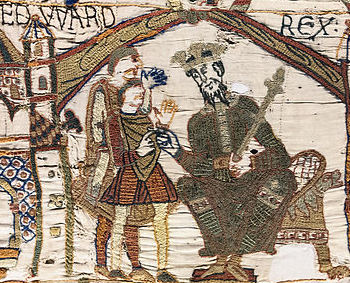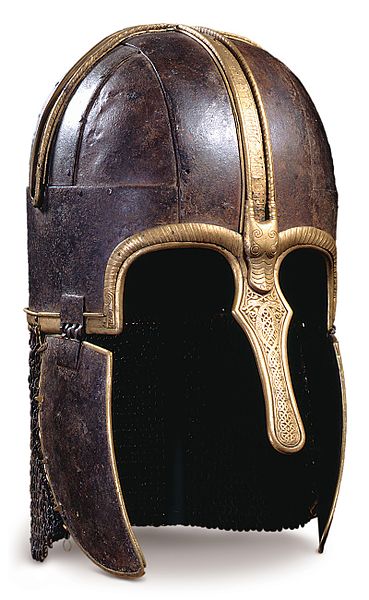Exeter Riddle 61
MEGANCAVELL
Date: Mon 10 Apr 2017Matching Commentaries: Commentary for Exeter Riddle 61
Oft mec fæste bileac freolicu meowle,
ides on earce, hwilum up ateah
folmum sinum ond frean sealde,
holdum þeodne, swa hio haten wæs.
5 Siðþan me on hreþre heafod sticade,
nioþan upweardne, on nearo fegde.
Gif þæs ondfengan ellen dohte,
mec frætwedne fyllan sceolde
ruwes nathwæt. Ræd hwæt ic mæne.
Often a noble woman, a lady, locked me
fast in a chest, sometimes she drew me up
with her hands and gave me to her husband,
her loyal lord, as she was bid.
5 Then he stuck his head in the heart of me,
upward from beneath, fitted it in the tight space.
If the strength of the receiver was suitable,
something shaggy had to fill
me, the adorned one. Determine what I mean.
Notes:
This riddle appears on folio 124v of The Exeter Book.
The above Old English text is based on this edition: Elliott van Kirk Dobbie and George Philip Krapp, eds, The Exeter Book, Anglo-Saxon Poetic Records 3 (New York: Columbia University Press, 1936), page 229.
Note that this edition numbers the text Riddle 59: Craig Williamson, ed., The Old English Riddles of the Exeter Book (Chapel Hill: University of North Carolina Press, 1977), pages 103-4.
Tags: anglo saxon exeter book riddles old english solutions riddle 61
Related Posts:
Commentary for Exeter Riddle 61
Exeter Riddle 9
Exeter Riddle 25



Commentary for Exeter Riddle 60
MEGANCAVELL
Date: Mon 24 Apr 2017Matching Riddle: Exeter Riddle 60
Brett Roscoe from The King’s University, Alberta leads us through Riddle 60’s commentary:
You know the kinds of kids who always have to be different? They stand when others sit and lie down when others stand. They dye their hair purple, and when the rest of the class dyes their hair purple they shave their heads. Well, that’s the kind of riddle we’re looking at. Almost all the other riddles in the Exeter Book fall into two large groups, 1-59 and 61-95. But Riddles 30b and 60? They refuse to conform, appearing instead in the middle of a series of Old English elegies (such as The Wife’s Lament and The Ruin) and religious poems (such as The Descent into Hell and Pharaoh). So the first question we need to ask is whether or not Riddle 60 is successful in its quest for independence.
Here’s the problem: the riddle is on folio 122b of the Exeter Book, and on the very next page (123a) is a poem called The Husband’s Message. Because of the proximity of these two works and similarity in phrasing, some have suggested that they actually belong together and should be seen as a single poem. If Riddle 60 were a teenager, I’m sure s/he would have thrown something at me as I wrote that last sentence, but it’s true. And those who want to see Riddle 60 together with The Husband’s Message usually hold that the answer to the riddle is a “rune staff.”
Artwork (by Olaus Magnus) from Wikipedia Commons (public domain).
This is a woodcut from Olaus Magnus’ description of Nordic history, customs, and folklore in a book called Historia de Gentibus Septentrionalibus (1555). It shows two wise men, each holding a rune-staff. And here is a picture of a rune-staff from 17th century Norway:
The Husband’s Message is, as the title suggests, a message from a husband to his wife. He was exiled, and so he has not seen his wife in years, but now he decides it’s safe to send her a messenger. The messenger finds the woman and tries to convince her to come to where her husband now lives. The messenger presumably shows her a rune-staff (or stick or stone) with the runes S, R, EA, W, M engraved on it, a cryptic record of earlier vows made by the husband and wife. In relation to Riddle 60, the most important figure is not the husband or wife, and not even the message. It’s the messenger. The Husband’s Message begins,
Nu ic onsundran þe secgan wille
[. . . . . . . . ] treocyn ic tudre aweox;
in mec æld[. . . . . . . . . .] sceal ellor londes
settan [. . . . . . . . . . . . . . . . .] sealte streamas
[. . . . . . . . . . . . . . . . . . . . ]sse. (lines 1-4a)
(“Now will I tell to you who live apart
How I grew up in youth among the trees.
On me must sons of men write messages,
Send me from foreign lands across the waves.”)
(trans. by Hamer, page 79)
It may be just me, but these lines sound very much like a riddle. And if they are a riddle, the clear solution would be a rune-staff, which is made from wood and engraved with messages. Admittedly, the messenger could just be a human who carries a rune-staff, and The Husband’s Message may not be a riddle at all. Though scholarly consensus favours the latter, either reading is possible. Seen in the context of Riddle 60, the rune-staff solution does seem tempting. A rune-staff speaks or conveys a message even though it is muðleas (mouth-less; line 9); it is pressed (or carved) with a knife that is guided by human hands and intent (lines 12-14a); and it can also be used to convey secret messages (lines 14b-17). In fact, in the Old Norse-Icelandic Völsunga saga Guðrun uses runes for that very purpose—she sends a secret runic message to her brothers to warn them of a plot against their lives (ch. 35). (Unfortunately Guðrun’s messenger is not as trustworthy as the one in The Husband’s Message. If you want to find out what happens, feel free to read the story for yourself—you can download a text and translation here). It would seem that a rune-staff fits a lot of the details of the riddle.
But what, then, are we to do about lines 1-7? These lines tell us that the solution to the riddle lives near the shore, that it is so close to the sea it actually touches the waters. F. A. Blackburn suggests that the lines describe a swamp, and the rune-staff is made from the wood of a willow or a swamp cedar (page 7), but this seems like a stretch to me. And what are we to make of the fact that the riddle solution speaks ofer meodubence (across the meadbench; line 9a)? As we will see in Riddle 67, written texts were often read out loud in public settings in the Middle Ages, but the last lines of this riddle suggest the message is a secret. Who would read a secret message out loud in a meadhall? (unless the person were exceptionally bad at keeping secrets!)
In fact, the present consensus is not to read Riddle 60 as part of The Husband’s Message. In modern editions and translations, the two are printed as separate works. And most now agree that the answer to Riddle 60 is a reed or reed pen. A possible source or influence can be found in Symphosius’ Latin Enigma 2 (called Harundo or Reed):
Dulcis amica dei, semper vicina profundis,
Suave cano Musis, nigro perfusa colore
Nuntia sum linguae digitis signata ministris.
(Sweet mistress of a god, the steep bank’s neighbor, sweetly singing for the Muses; when drenched with black, I am the tongue’s messenger by guiding fingers pressed.) (text and trans. from Ohl, page 36)
The interesting thing about Symphosius’ riddle is that the reed takes on a number of forms: first it is the nymph Syrinx, who, according to Ovid’s Metamorphoses (Book 1, lines 689-721), is pursued by the god Pan and transformed into a reed; then it is just a plain old reed along the bank; then it starts to sing, probably in the form of a reed flute; and then, as a reed pen, it writes. We’re dealing with quite a multi-talented reed here.
Similarly, Riddle 60 also describes a reed near the bank (lines 1-7), and then it goes on to talk of the reed as a tool. A knife is used to carve the tip of a reed pen, which is then gripped by a hand and guided by human intent as it is pressed onto parchment (lines 12-14a). The ic (I) of lines 14b-17 is the reed pen, and the þe (you) could be the reader of the lines (the person to whom the pen, through its writing, “speaks”), or it could even be the writer, in whose presence the pen “declares” its message (i.e. puts the message on paper or parchment). The pen speaks ofer meodubence (across the mead-bench) by writing books that are subsequently read aloud or discussed at meals. This last point may seem odd, given that the end of the riddle focuses on secrecy. But we have to keep in mind that, like Symphosius’ riddle, Riddle 60 lists more than one use of the reed. In fact, lines 7b-10a may not even be about a reed pen, but about a reed flute, played during meals as entertainment. Capturing all of these reed forms in a single English word is difficult, which is why I’ve added the word “pen” in parentheses to the solution. John Niles suggests that instead of answering Riddle 60 with a Modern English word, we answer it with an Old English one, hreod, which is flexible enough to mean reed, reed pen, or reed flute (pages 131-2).
So please join me in congratulating Riddle 60! It seems that it has achieved its independence after all. But it must keep its guard up—the rune-staff solution still lurks in dark places, just waiting to latch on to this fascinating riddle.
References and Suggested Reading:
Blackburn, F. A. “The Husband’s Message and the Accompanying Riddles of the Exeter Book.” Journal of English and Germanic Philology, vol. 3 (1901), pages 1-13.
Hamer, Richard, trans. “The Husband’s Message.” A Choice of Anglo-Saxon Verse. London: Faber and Faber, 1970, pages 79-81.
Krapp, George Philip, and Elliott van Kirk Dobbie, eds. The Exeter Book. New York: Columbia University Press, 1936, pages 225, 361-62.
Niles, John D. Old English Enigmatic Poems and the Play of Texts. Turnhout: Brepols, 2006.
Ohl, Raymond. The Enigmas of Symphosius. Philadelphia: University of Pennsylvania, 1928. (an online version of Ohl’s editions and translations can be found here)
Tags: anglo saxon exeter book riddles old english solutions riddle 60 brett roscoe old norse
Related Posts:
Commentary for Exeter Riddles 30a and b
Commentary for Exeter Riddle 67